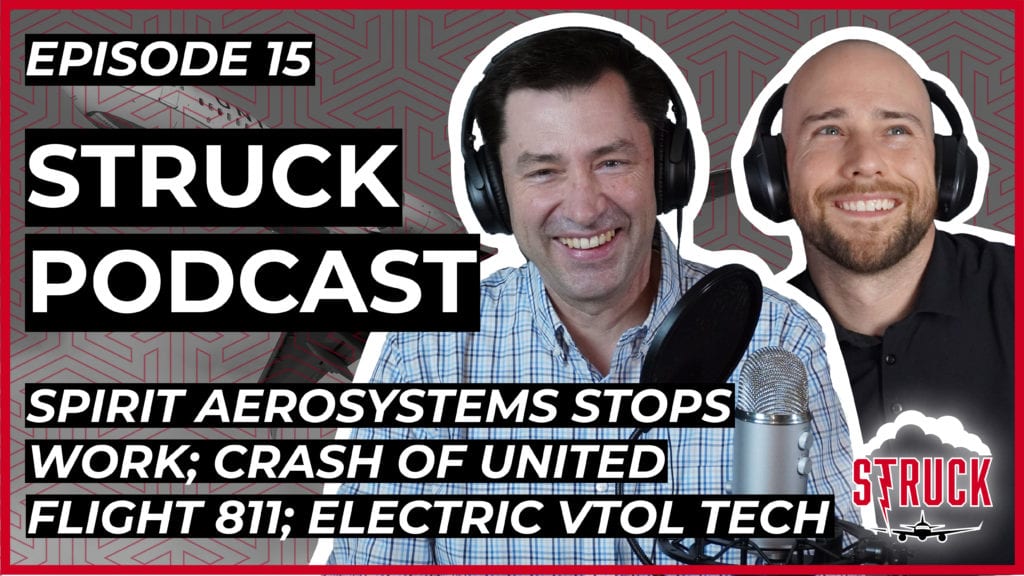Podcast: Play in new window | Download
In this episode we dig into more layoffs in the aviation industry, including Spirit Aerosystems, who is slowing down their work for Boeing. The final Airbus A380s were delivered, marking the end of an era. In our aerospace engineering fails segment, we discuss United Flight 811 and how a cargo door lock nearly took down the entire plane…Lastly, we touched on Joby Aviation and others, discussing some new VTOL (vertical takeoff and landing) technology.
Learn more about Weather Guard StrikeTape segmented lightning diverter strips. Follow the show on YouTube, Twitter, Linkedin and visit us on the web. Have a question we can answer on the show? Email us!
Full Transcript: EP15 – Spirit Aerosystems Stops Work; Final Airbus A380; Crash of United Flight 811; Electric VTOL Tech
Dan: This episode is brought to you by Weather Guard, Lightning Tech. At Weather Guard we support design engineers and make lightning protection easy.
You’re listening to the Struck Podcast. I’m Dan Blewett.
Allen Hall: I’m Allen hall.
Dan: And here on struck, we talk about everything. Aviation, aerospace engineering, and lightening protection.
All right on. So another week, another episode, how’s everything out there in Massachusetts
Allen Hall: Fine! Dan, you know, it’s weird. We were seen to be coming out of the coronavirus thing just fine, but now we’re in a drought. And I know last week we’re talking about a, was it locus or Cicada? What’s the crazy
Dan: books that we had.
Allen Hall: Yeah. So we’ve gone to from Corona to drought, insect infestations. So it’s crazy right now, in a still. Mid June, you know, it’s, it’s supposed to be, it is nice outside.
Dan: It’ll start raining snakes probably any day. So raining Cobra, dogs,
Allen Hall: any kind of small animal
Dan: snakes will come out of the toilet. That’s what all, that’s what it’ll be.
Allen Hall: It’s like that movie Snakes on a Plane, right? What’s not
Dan: a big, which was, which was funny. It was legitimately funny. Cause people like laughed at it because they thought. That it was ridiculous, but it knew it was one of those movies that it was satire. Like they knew it were that it was ridiculous. And I thought it was really funny.
I really enjoyed it. I got a lot of, a lot of acclaim at the time. A lot of fanfare.
Allen Hall: We finally, we finally hit bare season here. So we had bear in the yard this past week with some colleagues. So it’s a mama bear and a couple of Cubs gotta be careful around that.
Dan: Yeah.
Allen Hall: Spring, spring in the mountains.
Dan: Yeah, for sure.
So in today’s episode, in our first segment or in our new segment, we’ve got, about spirit, you know, they’re one of the big, part suppliers for Boeing. So some news there, the last . you know, end of an era is, as on our list here, we’re going to talk about some of the new developments and cabins and specifically seats.
Obviously this is big time re Corona virus. we’re also gonna talk a little bit about, United airlines flight eight 11. Which this is kind of in our learn from failure segment, which, obviously aviation has evolved a lot over the years and we’re going to talk about just how cargo doors have changed, in part, because of that incident, which is really, really fascinating, I mean, tragic, but a really interesting story.
And the investigation took some twists and turns. And then we’re gonna talk a little bit about. Airbus’s new drone copter and this potential flying car model. that’s after the Israeli Cormorant, which is, I guess not, it’s like a prototype vehicle, but it’s actually flown. She hasn’t had any passengers in it yet.
So, so Allen what’s, what’s the deal with spirit spirit
Allen Hall: is a big supplier to Boeing. It has been that way for a long time. They also supply parts to Airbus. And I think that you should have Gulf stream too, but there are big seven 37, seven 87 supplier to Boeing and with the seven 37 max, essentially on hold until we get to the flight testing, what it looks like flight testing with the FAA is coming up at the end of this month.
But the. They just had to put it on hold. They have so many airplanes on the ground already. Where are they going to do? You can’t keep putting more airplanes on the ground. So Boeing finally issued the stop, work to spirit now, but the things I’ve been reading about it are that the stop work is only for about two to three weeks.
At least that’s the initial cut on it is in a couple of weeks. Everybody’s going to be brought back. They think the flight test would be done. And then we’re. Quasi back to normal again,
Dan: which is
Allen Hall: good. It’s not permanent layoffs, but it’s still not any fun. Cause Wichita’s just getting hammered right now because Textron Cessna Beech have been shut down for a while.
and since Boeing is essentially pulled out of Wichita, it’s been pretty rough there and Bombardia, selling off all their business. Everything about the business airplanes. It’s been pretty tough times in Wichita.
Dan: Yeah. So it looks like yet, like you said, 21 day lay off. it was announced, Wednesday and so spirit, which makes the seven 37 fuselage.
Is it going to furlough or lay off temporarily about 900 workers. So, yeah, I mean, you don’t think, I think a lot of people out there don’t think about the trickle down, w you know, how many of these incredibly complex machines are parted out and subcontracted to so many other smaller companies that are yeah.
You know, essentially like those little, those little fish that, you know, follow the big whale. Right. And they they’re just along for the ride the whole time. So a
Allen Hall: lot of all the sub-suppliers get shut down when that happens. Wichita’s have a town of 250,000, 300,000 people. So you wouldn’t think 900 employees would make that big of a difference, but it really does have a significant impact on the community because those 900 people are not.
Going out to dinner. They’re not shopping. Everything kind of stops for them for a couple of weeks. Cause they’re going to try to conserve and do everything they can until the job starts again. So it’s a bigger impact on the community than just the 900. It affects a lot of families and it directly effects the economy in Wichita.
Dan: Yeah. Every time this
Allen Hall: happens.
Dan: Yeah. You just have to get used to it. Yeah. Hopefully we’re through this, this sooner than later, but you know, who knows, like we said, it could be, could be raining snakes before we know we have to halt all of our traffic because there’s too many snakes in this
Allen Hall: guys. Well, I’m flying next week.
I’m gonna be flying at a seven 37 something or another. And if we’re flying Southwest out to the West coast, so, you know, at least there is some traffic, it was this week was interesting. just buying tickets on Southwest because Southwest has really changed a lot of the rules. They’re not selling all the seats.
I think every middle seat is open. So you get out, not that there’s assigned seats in Southwest, but essentially they’ve booked. People for Isles and, and, windows seats. But at the same time, we were trying our usual trick of as frequently as I fly, I can do some interesting things in Southwest. They let you do them like book two flights at the same time going in different directions and they just shut it down.
So we had, played the usual Rotarix and the next morning Southwest had canceled all the flights. So
Dan: we had wait, explain that. I don’t know what that means. Two flights going into the direction. I mean,
Allen Hall: yeah. You kind of book options because you can cancel at the last minute at, on Southwest without paying penalties, or that’s how much penalties they just hold your money for the next flight.
You don’t, that you don’t lose all the
Dan: funds,
Allen Hall: you know, lose the funds. Right. So if there’s any chance that you may have to go a different direction, you. You booked both and then cancel one. As you get close,
Dan: what do you mean different direction?
Allen Hall: we were going to, we were going to go straight to the West coast and then we decided we’re going to stop in the Midwest and then go to the West coast.
So we had this one direct and one kind of two legged thing. And, Southwest said, no, you can’t do that. Mostly because I think they’ve gotten rid of the 30% or 40% of the seats on the flight and there they need every seat to be open. They don’t want to hold a seat and then you have your cancel.
Southwest flights are overbooked all the time. Anyway, my opinion. and before coronavirus, you could come and go as you please, because there’s always somebody else willing to get on the airplane, but. That stopped. So, gotcha.
Dan: Yeah. Interesting tactic.
Allen Hall: Yeah. We’re going to be on a seven 37 some sort, cause that’s all Southwest flies.
so hopefully we get across the country.
Dan: Well, yeah. And we need to talk a little bit about the, the seven 37. So they’re trying to get that re certified, but some of them are still in operation. Is that right? So explain that to me.
Allen Hall: Well, not that not the max is the Max’s aren’t right. So anything that had the, the, a new flight control system that, that was acting up and they had to recertify all those airplanes are immediately grounded.
Right? So they got grounded overseas and they got then the, the president granted him in the States. Those airplanes are not flying. It’s all the older airplanes, the seven 37, 708 hundreds are flying, not the dash eight dash nine, which were the maxes. so at some point though, that’s what Boeing was making was the Max’s and that’s what’s sitting on because I think there’s 400 plus airplanes on tarmacs right now of new airplanes.
They gotta deliver pretty soon. It’s gonna have to happen sooner rather than later, they can’t sit on those airplanes forever. but there’s a, there’s a bunch of going back and forth this week. between the European regulators, Boeing and the FAA, because CFA wants to get to a test flight. So does Boeing, because that’s sorta the last little checkbox before they can get back to delivering the aircraft.
And, it sounded like the IASA and the Europeans wanted some additional features to be put on the airplane like synthetic airspeed, which is a new thing for Boeing and Boeing declined to do, or at least declined to do that upfront and said they would do it. It’s sort of a software thing that they can add onto the airplane.
Dan: So, so that’s what you have. Can you explain real quick what synthetic airspeed is?
Allen Hall: so it’s not actually a true measurement of airspeed. They’re using at least the description I, and they, Airbus airplanes already have this. And so, I think he also was just familiar with it. It sounds like it’s a combination of some air data, but also a couple with GPS, position and GPS airspeed.
So it it’s sort of another check on airspeed. Think of it that way. So now it’s like an electronic check on the RSP that actually isn’t directly measuring airspeed. You can kind of, you can kind of cheat airspeed there’s when you get an altitude, there’s things about air densities that play into airspeed.
but in this particular case, we’re just trying to give you another, another bit of information to compare against. It’s not a bad idea. I just think Boeing decided not to do it early on. It didn’t have the music incorporated and they couldn’t do it on a, on a very quick turn notice. So Boeing sort of blocked and the FAA said they didn’t really need it, but it sounds like Boeing is going to agree to do it.
Which is fine, you know, I think everybody’s got to come together and figure out what the right direction forward is, is just when you get as many certification organizations overlooking a particular design, you’re going to have. Differing opinions and differing outcomes, because that’s what they’re familiar with.
Right? If we were down in Brazil, looking at the way that they’ve designed and airplanes, the authorities in Brazil would want it done differently because that’s what they’re used to the same thing with the ASA, same thing all over the world. It’s not any different, Russia’s different than the United States.
Oh, that’s fine. But if you’re Boeing and you’re delivering airplanes to all those different places, you’ve got to satisfy all those groups and that can get a little overwhelming.
Dan: Gotcha. So, the Airbus, a three 80, it looks like they’re delivering their final plan. So why is that the end of an era? Why was the
important or interesting.
Allen Hall: Well, it was really the biggest passenger airplane. It’s truly a double Decker, unlike the seven 47, which had limited upper deck, the 83 80 could haul over 800 people any time. And you know, it’s one of those crazy things you read about that. The in the United States, press you re re write it this way.
Boeing trick Airbus, and to building a three 80 Boeing feigned, like they were going to make this double Decker big airplane, basically take the seven 47 and put the double deck all the way down. The whole length of the airplane. Airbus didn’t have anything to compete with it. Boeing. Played it up enough and introduced it and said, they’re going to make it so that everybody’s had to go respond to it.
Then Airbus came up with a three 80 and Boeing set up. We’re not going to do it. And this left Airbus to hang out to dry. That’s what the press in the United States would say. I don’t know. So that’s necessarily true. I think Airbus is smarter than that and probably thought about that outcome, but I think they had a market for the airplane.
It’s a four engine airplane. Four engine airplanes are expensive on fuel. and, and it had limited places where it could fly because of the weight. And also, cause you had two decks, you had to unload. So that made it, difficult. And that there’s only certain places in the United States, which can accommodate it.
And that was one of the first hurdles. Then the second hurdle is it just never really had great sales. I don’t think any other U S big, bigger U S airlines ever incorporated one after all these years. And so that doesn’t really help an air, an airplane. You got to have a Delta. Or United or American in the U S to help keep the factory line running.
And they just never got to that point. So.
Dan: Gotcha. Just not widespread adoption.
Allen Hall: No. Yeah, it’s just not, it’s kind of like the, I want to say it’s like the con Concord, but it’s kind of like the Concord, he never had a us operator of it. You had British airways and you have your France and that was it. And you kind of run out of possibilities of delivering airplane at some point and they have enough and then you’re done.
Then you’re done. And that’s where the 83 80 is, but the three 80 still is a engineering Marvel. There’s no doubt about that. And, and Airbus had done a tremendous job of even creating that airplane, the miles and miles of miles, a wire it’s like a flying city. Right. It’s just enormous. And to even think that that was possible as remarkable.
So Airbus had done a good job with the airplane. It’s just really market and timing will kill all airplanes eventually.
Dan: Yeah, that makes sense. And then lastly, the, the Gulf stream. Is discontinuing the, yeah,
Allen Hall: that’s the big one that’s been around a long time. I think that came out in early two thousands and as the G five and then it went to the five 50, as performance enhancements happened.
But calcium is always just evolving into the next airplane that G 600 or six 50. Right. And then there was talk of a G seven. So there’s always an extra airplane. You always try and make the airplane one more efficient, more fuel efficient, for sure. And hopefully faster at the same time and, moral in their case.
I think more luxurious, right? The early gold screenings, the gold stream threes were nice airplanes, but it’s not a . Okay. And it’s not, a six. So, in terms of Gulf stream, putting, putting that airplane to bed would probably make sense cause they want to move on to the next airplane. And the next engine and the next performance increase, that all makes sense.
All it’s like auto it’s like cars, right? Every year there’s a new model car on airplanes. It didn’t really happen like that on airplanes. They’ll run it as long as there’s a marketplace for it. And then they upgrade it when the market gets soft and eventually you just sort of run out of time. No, it had ran out.
It was a good run, great airplane. People still love it. And the used market for that airplane is going to be astounding going forward. And so, you know, hats off to go stream. Nice, nice.
Dan: Maybe I’ll snatch up a couple of years. you know?
Allen Hall: Yeah. Just go, go on a little trip over to Europe, right. Just hop on. I mean, they’re there they’re great long, long flight airplanes.
People love them for that. Yeah, but it’s way out of our pay scales.
Dan: All right. Well, well subscribe to the show so we can get it’s only, you know, we get 2 million downloads, then we’ll probably be in the, in the realm. I don’t know. I don’t know how many podcast subscribers you need to have your own private jet, but
Allen Hall: a lot.
I don’t know. The two guys that started Google had their own seven 50 sevens. Yeah, it’s interesting.
Dan: It’s a lot of planes, a lot of planes.
Allen Hall: That’s a lot of plane for one person, which is what it was going on. yeah. I worked on those airplanes a long time ago, but yeah, that’s a lot of cash. I mean, that’s a lot of kids use your money for something else.
Yeah.
Dan: All right. So we’re going to start our, our sort of engineering segment on the show here. And we’re gonna talk about seats and cabin dividers. So obviously with COVID-19. Planes. I mean, every business, you know, we’re, you see it everywhere. There’s dividers and grocery stores. There’s all sorts of wacky things in, in, in restaurants, you know, the world’s changing just to give you a more personal space, essentially, you know, like what’s been happening, bathrooms forever, you know, dividers, you know, all that sort of stuff.
It’s coming to kitchens, it’s coming to, you know, just everywhere. So there’s a couple of different variations here that are happening or potentially happening for, for some of these commercial airliners, which one of them is a, it’s like a prototype that’s like that clear plexiglass kind of just boxing you in essentially to your seat.
So you have a plexiglass divider. And it looks like they’re in the process of trying to get certified for that. There’s another, a, this is like a middle seat. So it’s essentially replacing the middle seat with a sort of winged, divider section. it’s it looks like upholstered and kind of tapers into the middle it’s got cup holders.
So it’s essentially replacing that middle seat and it looks aesthetically like really nice. And then there’s also, just some sort of real simple kind of like almost like a sun visor in your car, but kind of folds. Just to give you a little more space and you could potentially rest your head on that.
just like these little wings. So, Allen, what do you, what do you think of some of these, these innovations? I mean, is this going to be in every plane? I mean, is this just the new normal? What do you think? No,
Allen Hall: not happening. And my appeal is not going to happen. Yeah. I don’t think it’s going to happen. one, because the cost is certified.
Things is high. Anytime you start playing around with seats and modifying seats, it’s expensive because the crash, the crash testing that has to be done, and there’s some weight, some weight things, weight limitations. So if you add so much weight, you have to go back and do some retesting because if you think about a seat.
It’s not a seat, right? It’s a crash safety device on some level that it’s made to absorb crash loads. It’s also made to absorb your head, hitting the seat in front of you or things that are around you, right? In a, in a crowd situation, your head’s gonna likely hit the seat in front of you. So it’s made to absorb that and not kill you.
so, so from a design standpoint, I don’t know. You know, I, my, my hope is that this COVID thing gets over relatively short, so we don’t have to make a bunch of Masa airplanes. Because if you’ve spent them a bunch of money and you install these things and then six weeks later, you’re ripping them all off.
Then what was the point of spending the money? It has to be something that’s going to be on there for a while. Or do you remember? I was talking to my wife about this. You remember when they had those little clips you could put on the seat in front of you, so they couldn’t recline the seat. Until, you
Dan: know, remember that,
Allen Hall: Oh, you don’t remember that?
I think it was a flight attendant had designed this little clip, so you can actually throw it on the seat in front of you so they could not recline their seat and smack you in the knees, which has happens to me all the time. but there, the FAA sorta outlawed those things because it’s part of the seat design as the movement of the seat and you’re restricting the movement of the seat.
So they outlawed them. If this little plastic clip has been outlawed, you can imagine how much effort is going to take to get these little plastic visors. And I’m not cool with things that I rest my face on any way on an airplane. Like the last thing I want to do is lay my face on a seat or any part of the seat.
I just don’t think, you know, think about it. Dan, would you, would you put your face on one of those things? If
Dan: yes, it looks very attractive, actually. It’s kind of upholstered. It looks real. It looks kind of dreamy. Actually. I just fall asleep right in it. Yeah.
Allen Hall: It just seems like a Corona blanket to me.
That’s what,
Dan: what it, well, that’s true. and I, I mean, you gotta assume that they’re going to use some advanced sort of antimicrobial, whether it’s a, you know, they’re going to use some kind of fabric. I would assume that’s not going to be just a Haven, you know, like a little Meryl Lago for, for coronavirus sitting on the side.
So you
Allen Hall: haven’t traveled with children. See, I think that’s the issue.
Dan: As soon as you travel with children, you realize
Allen Hall: there’s vomit and other orifices that are involved and they can all over airplane. So whatever time I walked the airplane, I just think this is just like a restroom, a human restroom. And I am not touching anything.
I don’t really need to touch here. It’s not much the airlines can do about it. It’s just the way that it is. And I think adding more surfaces is going in the wrong direction. I understand the air, the air flow. Think’s not that bad. Anyway. Have you haven’t you seen those little YouTube videos about how the airflow is on the airplanes?
Like I know Southwest, I saw one this morning. You sent me an email about the airflow on the airplanes.
Dan: Have you seen, well, that’s a. I haven’t, I haven’t been in depth with it, but that’s a good segue into this other technology that we’ll cover it. They have this, this new technology that they’re potentially putting out there where essentially it shoots a thin curtain of air.
So there’s actually like a slit cut into where those stupid nozzles are that shoot the air right into your eyeball and make you really cold and uncomfortable. Instead of those, this will just almost retro retrofit over him. It shoots a curve, like essentially just like a curtain of air down. And it goes from essentially your, your elbow rest, the armrest, and occurs over towards the window seat of the plane.
So this hap has one of these for all three seats. So it’s almost like boxing you into your own little cubicle. Where this air is making it like your force field. So the air is pushing down pretty fast and it’s not hitting you, which is nice. But I guess, I guess the theory is that if someone’s sort of like coughs into that, that jet curtain of air, it’s going to sort of hit it and get shoved to the ground and then kind of go into the plane’s HEPA system.
But. I dunno. How do you feel about that?
Allen Hall: Well, it sounds like they’re adding parts into an airplane, and again, I go back, anytime you Mount something permanently onto the airplane, you gotta get a certified and if has anything to do where a person could, if it could come loose in a crash and hit somebody, or you could run into it.
in a crash situation, there’s all kinds of testing to make sure it’s safe. But on the, on the second, second half of that is the airplane’s already sort of already forced the airplane, the air in the airplane from the top to the bottom. That’s how it works. The cool air it’s it’s summertime, essentially.
So the cooler comes into the top. It goes to the vents and off. Over the baggage, containers on top and all the airflow is down and a sucked out on the floor, the little vents on the side of the floor, and then a majority of it’s dumped overboard, but some part of it’s recirculated its to. Keep the fuel burned down, but it runs through HEPA filters and then it gets pumped back into the cabin.
Some percentage of it does like 25% of it gets pumped back into the cabin. I know I heard that the two 20, the newer eight to 20 can set up so that there is no recycled air, which I thought was interesting, but, most airplanes don’t do that. Most airplanes have some 20, 30% of the air recycle back in the cabin, but the airflow is already top to bottom.
Because aircraft designers are not idiots. Right. You know, you don’t want, I mean, they, they realize that they want to try to keep the air clean in the cabin. That’s how you do it. You suck everything down to the floor and then take it through filters there. so adding to that system, every, Airflow engineer at Boeing and airbrush is cringing.
When they see something like this, like I designed the system to work. It works great, stop messing with it. I, I vote for the Airbus engineers and the Boeing engineers that are throwing their hands up at the minute. Just don’t don’t mess. Don’t mess with it because you’re never sure what the outcome is.
If it causes corrosion or some crazy other secondary effect to happen. That’s the worst thing, you know, a lot of these systems have been designed and tested over. Dozens and dozens and dozens of millions, a years and millions and millions and millions of flight miles. They know why the system responds and how it’s supposed to work, how to maintain it.
You throw something else on top of it like that. Then I start to wonder if we’re thinking this thing through the secondary effects. We have no idea. Right.
Dan: Well, I get that, but at the same time, they didn’t think through those nozzles that well, because they’re they go right in your eyeballs and they make you cold.
Yeah. They’re not, they’re not great feats of engineering. I’ll just leave it at that. I think they could reengineer that one little, the air nozzle easily, the most unpleasant, most difficult to adjust feature. I think of a flight. You try to get enough air. So you’re not, so you’re not cold. And then suddenly you’re cold.
It’s like blowing in your face. The most confusing could be a better diffuser, a better diffuser for it.
Allen Hall: Oh, okay. I’ll grant you that the ones we use in business airplanes, a business jet airplanes tend to be better.
Dan: Oh, you’re so fancy. Yeah. Well, well I’m not paying you a thousand dollars per hour for flights, but yeah, it should be airplane.
Yeah.
Allen Hall: But the most confusing feature for every flight attendant in the world. And the most annoying one is the flight attendant call button that’s right next to the light button, which gets constantly pushed on every flight I’m on, you know, on the light comes on the flight attendant pops up and you’re like, I hope that’s not an emergency.
Oh no, it’s not an emergency. This they’re trying to turn the light on. So the flight attendant has to walk all the way to the back of
Dan: the airplane. I need a ginger ale, Sally. I need a ginger ale. That’s right. And yeah, come on, come on.
Allen Hall: If they I’m thinking well, if they can fix those little, air devices have a name, which escapes me right now, but if they can, if they can fix that, they can sure.
Fix the flight attendant, call button,
Dan: you know, who we need to call in. There’s one man for this job. Do you know who he is? One inventor for the air for the airflow James Dyson. James does.
Allen Hall: Oh yeah.
Dan: Get him on an airplane. He will sort this out. He’s our savior in this situation, I listened to his, I listened to the guy Raz how I made it or how I built it podcast with him on there.
Yeah. Yeah. A shout out to that show, which I think is great. But his episode was really cool. He’s one of the very few people that owns the entire Dyson company. Which is crazy. Cause they’re like a multi multibillion dollar company he owns every share of that company is crazy because he just grew from us.
I mean, he was just like growing it from, you know, going door to door, selling vacuums, just never got to that point where they needed. Venture funding and it just started to take off and there they went and suddenly it was a billion dollar brand and he owned all on crazy. Wow. But he’s the man for this job.
They’ll look, emailer, they’ll look cooler. It’ll have some like turbine airflow or cyclo and airflow. And it’s like, it has to be a
Allen Hall: cycle and airflow.
Dan: Yeah, well, that that family have is really cool. That oval fan that, you know, it shoots has jets of air shooting in the they’re, the ring of it. And it pulls all the other air through the middle of it, just using that.
But it’s several
Allen Hall: hundred dollars for a fact and
Dan: you won’t move all people should pay for the engineering. I’m a little disappointed, but all right, we’re going to, we’re going to move on to our next segment here. learn from failure. You know, some of these engineering, mistakes over the years and granted the industry is extremely safe, but we’re gonna talk a little bit about United Airlines flight 811.
So this one is crazy and you and I both listened to about this in a, that book that we referenced in a previous podcast, the checklist manifesto. And so the, the cliff notes of this flight. Or that the cargo door, this is a 1989 United airlines flight. The cargo door, had a latch issue and came a jar just enough to be, you know, blown off by the pressures and aerodynamics of the plane hit the, the fuselage punched in 11 by 20 hole in it immediately sucked out nine people.
And then obviously the plane was in crisis mode from that point on, but, but landed safely beyond that, which is pretty remarkable. so Allen, you read through the report, how did this happen?
Allen Hall: Well, the way that cargo doors were set up on that on the 747 and a lot of airplanes that they were not plugged doors.
And what I mean by plug door, it’s like a. A stopper like at a sink, so that, the pressure actually forces the door closed against the aircraft’s skin. Right. That’s the way like emergency exits are designed today
Dan: inside the plane, pushing it towards the outside.
Allen Hall: Correct. Right, except definitely the new 737, which they have a little, their hinge.
So the older airplanes, like a DC nine had a plug door, because anytime you landed, he could smell jet fuel was sucked. but the, the, a lot of the doors are plugged doors. So they, the, the forest, the pressure and like in the cabin, Actually pushes the door closed and it has nowhere to go it’s doors trapped on that 747.
It was like a regular door on your, on your house or your car. And we’re like your car where it’s just hinged and the door opens outward. So I think about pressurizing your car, you can put in a pressure in there where the, the latch mechanism would fail and that door would pop open, which is kind of what happened.
Except in this case, the investigators went after that accident, the door was lost. I mean, the door hit the ocean. Right. So they didn’t have the door and they didn’t have anybody who knew anything about it because the people that are closest to it were killed in that accident horribly. so the investigators had gone back and looked at other incidents that had happened and decided that, well, it was some sort of mechanical failure.
Like the, these got these little cams. I don’t want to describe a camp. I just like the
Dan: call scene. They call them long sectors. Yeah. Yeah. They’re made of aluminum and a little bit too thin. They said was part of the issue.
Allen Hall: Yeah. And so they thought my way they’re not taking the load are not fully engaged, which if the airplanes bounce around, they can become less engaged.
And the pressure on the air in the side of the airplane cabin, it could be forcing the door open. one of the victims, families. Decided to keep investigating. They thought that answer was not correct and didn’t make a lot of sense to them. So they, they sort of self-funded, more research into it and they eventually found that door in the ocean because 14,000 feet down as some crazy number.
Right. Bring up that door and realized it wasn’t, it wasn’t mechanical failure. It was an electrical failure. The electrical system, opened the door essentially in flight, that there had, some wires that shorted inside the fuselage that told the commanded the little motors that opened the door to open the door and flight.
Well, There’s no, really no way to know that. Right. And then the reason that the investigators kind of figured that out, they had a similar accident incident happened on the ground where they had a circuit breaker blow and the door tried to open. And one of these airplanes and I’m like, wait a minute, maybe we need to go back and look at the wiring.
And they realized the wiring old wiring tends to lose insulation, become very vulnerable to arching and sparking between wires and wires can touch. Cause they’re not necessarily. As restricted a movement as we in theory would like them to be and wires touched and bingo. so you know, that’s a weird one, Dan, don’t you think?
Because, because the initial investigation was just so far off the final answer, they weren’t really that close.
Dan: Yeah. It was, it was strange. And for the family. So Lee Campbell was the new Zealander who was one of the nine. And yeah, his parents, Kevin and Susan Campbell, they, they took it upon themselves to go deeper.
And I’m not sure that they exactly got the, the, the mechanism right. Of, of failure, the exact mechanism. It seemed like the recovery of the door was really what put, what finished it off, but they definitely got, I mean, they got Boeing to, or not Boeing, but they got the NTSB to. To reopen the case and start investigating again.
And then they somehow found that cargo door, which is again, it’s miraculous. Yeah. 14,000 feet below the ocean. How
Allen Hall: power easy number. Yeah.
Dan: Yeah. Like we don’t even know like how many planes or other things have been lost at sea that we don’t even still don’t even know where they are, which is just crazy to think about.
You found that door. That makes no sense.
Allen Hall: Yeah, but the pilots had one hell of a flight too in that, right. Because the ox they’re at they’re at altitude and when the cargo door let go, it ripped out the basically ripped out the oxygen systems of the pilots didn’t have oxygen and they’re at altitude. So they’re putting on mask and realize there’s no oxygen.
Which is a double emergency. Now you do it. Not only do you have a hole in the side of the airplane, but now you’re at altitude and you don’t have any oxygen and you don’t have a long time before hypoxia sits in and you will go unconscious or at least forget what you’re doing and start making stupid decisions.
And so you have to get the airplane down. Fast.
Dan: Yeah. So, and that was why this book was referenced in a, in a checklist manifesto, because in this situation they didn’t know what was going on. Like they heard a thump, I think is a, well, that was, I think what the door leaving, I suppose. Yeah. but then the, the, the, they thought it was a terrorist attack.
They thought it was like some sort of like a bomb. They didn’t know what happened and they couldn’t get, they couldn’t get ahold of the crew. So. The, I guess not the, not the captain, but the, you know, one of the second in command in the, the flight crew, he goes out to see what’s the, you know, what what’s happening?
And he sees a 10 by 20 hole in the plane. Like, I mean, what, at that point. Yeah, just what a crazy situation they all found themselves in. And so, yeah, they lost quickly numbers, their number three and four engines, because, you know, debris ejected from the plane was going into them. And unfortunately it sounds like a couple of people went into the engines and, yeah.
So from there, they, they started to lose cabin, lost cabin pressure and had to quickly decide what to do, which they had eventually settled on all that we need to get down to 8,000 feet, you know, as quickly as we can, as we safely can so that we can. Do this without a pressurized cabin, which they successfully did and, and everyone else was on that plane when Atlanta, which is crazy.
So
Allen Hall: just tells you what, the level of training of the pilots, even in that situation, they knew what they needed to go do. And they worked on that checklist to get the airplane back to the some level of safety. That’s well trained pilots will do that. Right. They’re they’re prepared for most instances, not the same.
You’re necessarily prepared for the door to come off the airplane. That’s not a normal, day of flight, but, the door opening is one of those checklists things that if the door does pop open, what do you want to do? You want to get the airplane down to around 8,000 feet? So you don’t blow it off the airplane, but at this point it was already too late, but the same checklist applied essentially crazy.
Dan: That’s amazing. Mean you can imagine. Just like the gaping look from the crews, lazy comes out to see what the commotion is about and sees a 20 foot hole in their plan. Like something you’d just never expect to see and then make really good decisions from there on out is, yeah, it’s, it’s remarkable. I mean, that’s just, you just never expected.
It’s like going down, you know, you just wake up and you go down to your living room. There’s like a tiger in your living room. Like what is happening right now? You know, like,
Allen Hall: Checklist
Dan: tiger. Tiger and basement. Right? Exactly. What is, what do you do there? No one knows, but yeah, I mean, it’s pretty all out of there and just the, well, I think the big takeaway for me, as a, as a non aviation lifer is just how much there is to lose on every given part of the aircraft.
Like how well engineered every single part has to be. Cause that lock, which was complicated for sure. It was not just like a simple, you know, outdoor outhouse latch. Yeah. Very complicated, but had a, you know, a confluence of factors leading to. This entire plane, almost crashing, which is crazy to think about how every part has to be engineered to such a high standard.
Allen Hall: That’s that’s a difference, I think, in the last 20 odd years or so, it was just a level of rigor and safety that we put in airplanes. It’s, it’s remarkable how much time is spent on that.
Dan: Well, in something like this, I mean, I need to see a photo of, I actually, haven’t seen a photo of like what this latch looked like, but the way they’re describing it, I can’t even.
In my mind makes sense of what this latch looked like, because they’re talking about the complex, you know, it, it rotates into place and it has cams and it has all these different sectors in it. And you know, how do you design that? And then say, okay, this is going to work a hundred percent of the time.
Like we contested this, these kinds of things will never happen. It just seems like, like I said, lots of engineering ends even the little sort of afterthought kind of parts.
Allen Hall: Yeah. It’s it’s any, any door is complicated. And if you’ve been, I’ve been around too many doors and know how fussy aircraft doors can be, because there’s so many latches and locking mechanisms and secondary fault features built into those doors so that they don’t come open and that, you know, that they’re securely attached and there’s visual indicators, you can look at to make sure that the door is engaged and all the cams are locked in.
Like they should be. It’s not, it’s not a simple mechanism. It’s not a doorknob. Yeah. By any stretch of the imagination, it’s nothing like that at all. it’s more like a submarine hatch. I mean, it’s, it’s that kind of complexity or like in the, if you looked at the Apollo capsule hatches, it’s very similar to that where there’s just redundancy and resiliency and redundancy.
Yeah. It’s complicated.
Dan: All right. So our last segment of the show, we’re going to talk about a little bit of new technology. And, today we’ve got a couple, so Alan, there’s a lot going on in the vertical takeoff and landing industry specifically with, obviously I think the big development is, is just electric, vertical, takeoff, and landing.
So we got a couple and we’re going to be doing a lot of different, Content on, on some of these different aircraft. Cause there’s, there’s so many different ones competing for, it just seems like, I don’t know what your take is. Are they just competing to be the first to market? Is that really just the plans right now?
Allen Hall: Yes. Oh, for God’s sake. Yes.
Dan: Hundred percent. Okay. Easy answer. It’s just, it gets a Mark.
Allen Hall: Well, it’s like anything else, right? You gotta be first to market with a product that makes some sense. Now the real thing watching from the outside in, you know, it just. You, you watch all these different aircraft companies that are eventually, eventually trying to get to the same sort of thing.
And I don’t, I don’t know if that ever makes sense. Like the thing that there’s always going to be this huge commercial market, like the average Joe, like me, is going to walk out to the driveway and go fly down to the local. Quickie Mart. I don’t, that, that, that ain’t happen in my opinion, in some parts of the country, in the world.
Yes. 100%. Yes. But for a large part of it, probably not. Right. Because it’s just not designed for it now. I read that was it this week where, the Lilium, Vitol aircraft company is worth a billion dollars us dollars. Like that seems impossible, but okay. Say they got a billion dollars. If you can’t build an airplane with a billion dollars, then it’ll never get done.
and some of these exercises are great, but at the end of the day, you still have to execute. And I’m, I’m never confident looking at some of these companies to think that they’re going to execute it. Now, Lillian may be able to do it. There’s a couple others. Joby aviation.
Dan: Joby’s a big player. And I think they’ve probably got to have a bigger valuation.
I don’t have that number in front of me, but Joby raised almost $600 million recently, a large chunk of it from Toyota. So they’re right here. Well-funded
Allen Hall: yeah, but you should be able to build an aircraft that size for a billion dollars. Come on. That’s that’s not that’s way too much money to build an Allen
Dan: Allen.
It’s 2020. Okay. You don’t have, if you. I mean, I get where you’re coming from, but what you do today is you race to a really high valuation. You raise a ton of venture capital, and then you lose $3 million, $3 billion a quarter. And then you’re great. You’re, you know, you’re everyone’s favorite Uber or whatever.
I mean the whole year, right? That you should a hundred percent. We had to build whatever it is you’re trying to build for that amount of money. But I think it’s
Allen Hall: a car. It’s a car that you love to spend that money on a car.
Dan: He’s actually building stuff with his money, which is which I do appreciate because none of these aircraft companies have actually, I mean, they’ve got some prototypes.
Allen Hall: I haven’t even flown. Somebody didn’t have any Florida, a full size prototype, nor are they flying with anybody inside of it, which is sort of the kicker for me. Like, alright, when we get to the point where we’re putting a human in it, then, then when they we’re getting close, we got to get somebody flying inside of these things, not just automate them and control them from the ground.
that’s not where it needs to go because you’re never going to certify it that way. So what are you going to do? You gotta get, you gotta get a real person in there and you gotta have the confidence to fly that person inside of it. I don’t know if it’s a confidence factor that is lacking right now or a, or a, they’re not sure that the engineering is quite right, but in either case somebody has got to get there first and they need to get there pretty fast for as much money is being poured into these aircraft programs.
Dan: Yeah. And I agree with you. I mean, the, the, the valuations of companies today is bizarre, which I think that’s starting to take a change, right? Like they’re not there. People are definitely getting wary of investing in companies that aren’t making money. Like we work, there are spectacular collapses past year, right?
Uber is under a lot of scrutiny because Uber is still very far from profitable. Right. Right. And so, you know, as Americans, we see these big companies and think, wow, Hoover, like this ubiquitous service. But they’re not a successful company. Like the pizza pizza chain down the street, or not even the pizza, the, your local greasy pizza place down the street makes money.
Like they profit. That’s how they stay in business, but Uber is hopeless in their water. And so these companies they’re like, all right, Hey, here’s our prototype. It’s four years away. Like they’re not going to make any money for a minimum of what, six years, seven years. So these valuations, it’s strange because what’s the value of a company that doesn’t produce any revenue.
You know, that’s how much cash they have on hand. Well, not even that much cash, the multiple of the caps that have on hand.
Allen Hall: Usually there’s a sort of aircraft number 50. Think of it that way. On business jet programs, there were set up that they’re losing money. Until they get to aircraft 50. So when they sell aircraft 50, then they’re kind of getting in positive cashflow territory.
Now that never is the case, by the way, it’s somewhere way beyond that typically. So they’re trying to dig this huge cash hole and then try to dig out it with aircraft sales and part replacement and part sales later on. And that’s why. A lot of aircraft companies don’t really develop new aircraft, so to speak as much as they, renew update, and enhance, put a new wing on or whatever they want to call it.
There’s not a, he, they don’t want to pour a billion dollars into a new aircraft because he may never see it come out. If you think about the pricing, you’ve got to have some play in it. the only, and the only thing that really sticks in my head about these electric vertical takeoff and landing aircraft is that they’re going to have some of the revenue stream.
If they’re used as a taxi service, like every flight, they’re going to get some percentage of that, of that. Sale transaction, otherwise, what are we doing? so I I’m really anxious about this because if, if we just keep throwing, you know, it’s investors can do whatever investors want to do. It’s totally fine with me.
You don’t have to ask my opinion, whether a particular aircraft company is going to go. But if you do ask a lot of engineers that have been around a lot of these aircraft companies, which one’s likely to succeed and which ones aren’t. That’s a pretty short list. Most of the mostly engineers are going to be able to tell you these three or four, got a good shot.
These other 150 or 160 are never going to make it to market. At least not in the, in the personal market where they put people inside of it. And maybe drones for carrying cargo or drones for moving produce or whatever they want to do. But when, as soon as you put a human in it, you got a lot of, of. Tasks and expenses to go.
Do, do you have the engineering staff get it done? Do you have the sales people to drive the sales so that you can get yourself out of that financial hole? To my opinion, now, most of them were not going to make it
Dan: well, it’s funny you bring that up because I actually have plans. so if you wanna invest my new company, it’s going to be an electric drone, tomato transport company.
So since you mentioned, yeah, transporting produce. we’ll call it the tomato, the tomato flyer. So yeah. Yeah, sign up now, if you’re out there, if you’d like to invest. No. So let’s talk about, so the Airbus helicopter, let’s talk briefly about that specifically. I mean, all these designs are similar, right?
They have lots of smaller propellers, which reduces the tip speed and thus the, the noise tremendously. what did you, what do you find unique about the Airbus? I would say that one’s a lot bigger than some of the big ones. Like the, the Joby and the Lilium, the are small they’re small, they’re like four projected to be four seaters plus or minus.
Right.
Allen Hall: Their best one I thought was interesting because of the size of the, of the aircraft. It’s like a regular. I a regular helicopter, but it’s like a regular helicopter fuselage section that they’ve mounted for electric fans on and rolls Royce seems to be the electric motor of choice recently. And, and the Airbus case, again, it was in a drone mode.
It didn’t have anybody on it. But what I, when I first saw that aircraft, I thought that is an aircraft to get people to and from oral rigs or offshore, whatever wind turbine sites, you name it, it’s going to pick up, get you there and get you back relatively. Where he can load a lot of people inside of it, because like the Sikorsky S 92 is a very popular helicopter to do that.
And that I forget how many people that holds to get you from a, to B it’s a lot. It’s, it’s more than 10, I think. So I think at 10 workers that need to get from Scotland to this oil rig somewhere, then they can fly in this helicopter. So it may be a good substitute for that. Maybe more efficient, maybe a, I don’t know.
So you get to this sort of aerodynamic thing, like what is, what is the mission? Where are you going to make sales? Because sales fixes everything. And if you don’t have sales, then what are you doing? You got to have a lot of sales up front, you got to lock in those sales and you’ve got to deliver to make the money.
And you got to know. That’s your only way out of this financial hole, you’re about to dig and I may not make it a whole make like a crater, like a moon has run into the earth kind of size hole. That’s kind of Holy take yourself when you’re in these programs, you know?
Dan: Well, it’s funny you mention that because we were talking about, the job board on Joby aviation’s website.
Yeah. Yeah. It’s vast, there’s like 50 positions that they’re trying to fill. Yeah. And they’re probably all what, $200,000 jobs. I mean, high level engineering positions, you know,
Allen Hall: I don’t know if
they’re
Dan: that much, but six figure probably, or at least close
Allen Hall: the six figure of you. For sure. So
Dan: I think about the cash salary.
Yeah. It’s a big cash
Allen Hall: cash burn and it’s the most expensive place in the planet. Silicon Valley is not cheap. So the cash burn starts to add up and
Dan: well, they can burn scares you or they can build these planes via zoom can’t they.
Allen Hall: Well, maybe
Dan: that was a joke as a joke, but, obviously in design than ever I’m. Sure. Yeah.
Allen Hall: Well, you have to, at some point you gotta build parts. You gotta assemble parts. So you gotta have somebody putting the. Part a, to part B with some screws, but engineering wise, there were some, there was some engineers that would gladly work on site for their own sanity.
yeah. I mean, a lot of times you just need a CAD screen and an internet connection and you’re totally fine where no one’s bugging you for hours on end. That would be a dream for a lot of engineers. But, you know, at some point you gotta make, gotta make this thing.
Dan: So. Yeah, won’t help. Yeah, that’s true.
But yeah, it’s interesting. And obviously this other one, we’ll touch on is the Israeli Kormoran. So have you seen this thing? It’s more like a, sort of like a blade runner style. Yeah. Which I what’s funny is, and
Allen Hall: it is, it totally is. Yeah.
Dan: Yeah. And my instincts could be way off on this, but when I saw it.
I was like, Oh, that actually, Hey, it does look more like a flying car. Whereas all these other ones look like mini helicopters. They have like pretty white futuristic, smaller helicopters, but this one actually looks like a flying car because the, it has two fans in it that are built into essentially where the hood and the trunk would be.
And then the rest of the body is boxed in where could actually like bump into stuff where if you ever really wanted something, maybe actually on the street, this would be much safer. It would be like chopping off street poles, you know, be a little, like I said, more of like a bumper car. but what do you think of that design it’s it’s it’s quirkier for sure.
They they’ve tested it. Unmanned. And obviously a lot lighter than having, you know, four people in it, five people in it, but, their plans are for 20, 28. So coming to in eight long years, which is kinda makes it just kind of makes me laugh. That’s like, yeah, that’s there. That’s what it does. Our website.
That’s really far out. I mean, 20, 28 will human beings will just be avatars. Like I’ll just be living on Mars in a holiday. I’ll be a hologram. So I don’t even need that. I’ll lay in bed all day while my avatar, which is a hologram just runs around the city. So I’ll just tell her
Allen Hall: that when I looked at the aircraft, I don’t know about you.
Maybe I’ve been jilted or jaded, after all these years of looking at airplanes, but my first thought was. That’s a military thing.
Dan: It does very military. Yeah. And that was part of the design is that it could sneak. Pretty much anywhere and almost into the wilderness and kick some butt and pick somebody up and bump into some trees and not, you know, all that sort of stuff that was part of own.
Allen Hall: And then you pick anybody up there. They’re taking somebody out, it, because it would be perfect for like a S a seal group of seals or army Rangers, or somebody to drop in unexpected at some part of the world and do some damage and get the heck out with. Before they even knew what happened. That’s what it looked like to me.
It also had the shape of something that was stealthy. And again, it’s small enough, there’ll be very hard to pick up on radar. It is shaped like something stealthy, which, you know, it’s like the , it’s kind of got those angular shapes, like, Hmm. I wonder how RF bounces off that thing. Oh, it’s probably got a pretty low arm cross, cross section.
Okay. So if I fly close to close to the ground, I’m pretty stealthy. I can probably put six guys in this thing and I can be anywhere and 300 miles within the hour, you know, that, that kind of thing. Then it has a lot of uses. So I kind of wonder if the 20, 28 expected delivery date was for the commercial civilian version of the
Dan: thing.
It is actually like, it’s really it’s for the, yeah. In New York city walk out of the pizza place. Get onto this car, like blade runner, which
Allen Hall: I’m just
Dan: laughing. I mean, it’s not unreasonable, I guess. I mean, because
Allen Hall: it is, it is unreasonable. Let’s get to that quiz. Get that out right now. You don’t worry.
There’s no way we’re flying down. Fourth Avenue or whatever, or 52nd street in New York city and getting pizza in this thing, you know why? Because you’re going to run into a building and kill a bunch of people. So no, that is not happening. It is not happening. I remember that. And it wasn’t that long ago we had a helicopter crash on top of one of these buildings to follow the fall to the street.
I’m pretty sure that’s within the last 10 years, that was
Dan: in the movie diehard actually. No, no, no, no,
Allen Hall: no, no. Remember, Oh, I’ll give you another one. All right. So let’s take that one off the table and say Bruce Willis did that, but I remember when the Yankees pitcher flew into the building in New York city and that little in the little
Dan: airplane.
No
Allen Hall: Cory Lidle. Was it Cory Lidle did that? Yeah. I like keep the hell out of the city. Don’t do that. because I don’t want an airplane to come in my office window. It’s just, there’s just too many unknowns of airflow and turbulence and all this stuff in the city. That’s not the right place for these things.
If you want to fly from your rooftop in one SRAs to where the next rooftop in Buenos Aires, cause you don’t want to ride on the street. Fantastic. If you want to do that in Los Angeles, hop from rooftop to rooftop, go to your Hollywood hella pad to your movie set. Great. But I’m just Tanya. There is no way you buying pizza in that thing ever, ever.
Dan: Okay. All right. You heard it here first. You’re never getting pizza. In a flying car,
Allen Hall: you know how you get pizza? You call Domino’s and they just drive, Stripe it over. Or they sit in the little tiny drone. I’m okay with that.
Dan: All right. Well, that’ll do it for today’s episode of struck. If you’re new to the show.
Thank you so much for listening. And please leave a review and subscribe on iTunes, Spotify, or wherever you listen to podcasts. Check out the weather guard, lightening tech YouTube channel for video episodes, full interviews and short clips from the show. And follow us on LinkedIn, Twitter, Instagram, and Facebook.
Our handle is at WG lightning tune in next Tuesday for another great episode on aviation, aerospace engineering and lightening protection.
Strike tape, weather guard, lightening tax proprietary, lightning protection for Ray domes provides unmatched durability for years to come. If you need help with your radon lightening protection, reach out to us at weather guard, aero.com. That’s weather guard, a E R o.com.












